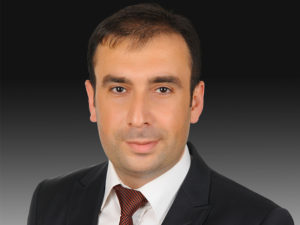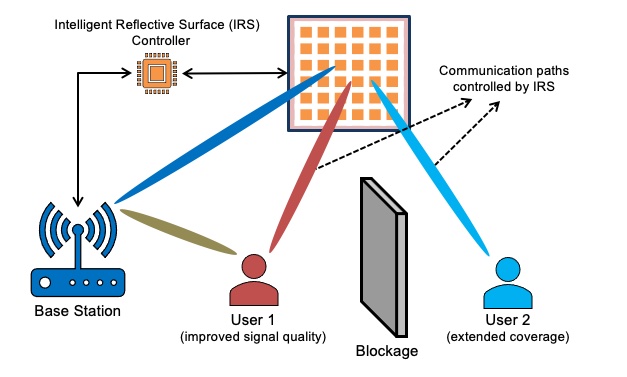The electromagnetic spectrum we rely on for communication and more has become a packed multilane freeway. Cellphones, WiFi, Bluetooth, radar, satellite radio and television, not to mention AM and FM radio, compete for finite frequency slices. And yet, communications companies and consumers demand even more bandwidth as wireless technology flourishes.
 Sabit Ekin wants to open an unused lane on this data turnpike: the terahertz band, squeezed between standard radio frequencies and visible light and subject to the rules that govern both.
Sabit Ekin wants to open an unused lane on this data turnpike: the terahertz band, squeezed between standard radio frequencies and visible light and subject to the rules that govern both.
There are reasons, however, why terahertz is the last frequency frontier. To compensate for its shortcomings, the Oklahoma State University electrical and computer engineering professor will wed terahertz with visible light communication (VLC) in a hybrid network. He’ll pursue the pioneering approach with a five-year, $789,081 Early Career Research Program award from the Advanced Scientific Computing Research program in the Department of Energy (DOE) Office of Science.
“We are going to holistically, backed by experiments, integrate these state-of-the art technologies, which are regarded as the key enablers for the 6G-plus cellular telephone and WiFi-plus networks of the future,” Ekin says. Such a system also would match DOE’s needs, providing short-range transfer between servers or processors in data and supercomputing centers or in facilities such as nuclear reactors and particle accelerators where radiation shielding limits standard radio communications.
Ekin calls his project CommAwareNet, for communication-aware, energy-efficient and reliable network architecture. Communication awareness largely refers to his proposed system’s third element: intelligent reflective surfaces that will direct radio and light signals around obstacles to receivers. “Imagine if you build your walls in a way that they’re helping your communication links increase their coverage and data rates,” he says. To do that, “there has to be intelligence in the communication.”
Ekin, a native of Turkey, joined Oklahoma State in 2016 after earning an electrical engineering doctorate from Texas A&M University and working four years for Qualcomm, a leading cellphone microchip manufacturer. After academic research that largely focused on simulations and theory, he enjoyed the hands-on practice of working across disciplines, including with software, hardware and testing engineers. Ekin says the combination of experiences equipped him to approach the CommAwareNet project both theoretically and experimentally.
With the rise of networked thermostats, appliances and other devices comprising the Internet of Things, the demand for wireless spectrum capable of high data rates is accelerating and eventually will overload standard radio frequency technology. Most radio communication, including for cellphones, Bluetooth and WiFi, tap the sub-6 bands, so named because they’re at frequencies below 6 gigahertz, or 6 billion cycles per second. They’re the most useful because the waves penetrate most structures.
Seamlessly changing between the two transmitters and receivers is at the project’s center.
Most researchers define the terahertz band as from 0.1 to 10 trillion cycles per second, at the border between the radio wave spectrum and visible light. “These frequencies have huge bandwidth,” Ekin says, with large and fast signal-carrying capacity – but can’t penetrate most structures. Transmissions must follow a line-of-sight path, with no obstacles between transmitters and receivers. Parts of the terahertz spectrum also suffer from signal loss over distances, and the waves are narrow and directional, providing limited coverage.
VLC shares some of these faults, but it’s an inexpensive and tested technology. LEDs used for standard lighting can be made to flicker millions of times a second, sending data to optical receivers; the flashes are so brief that humans can’t perceive them. VLC is ineffective outdoors because sunlight washes out the signals, but it’s easier to manipulate than terahertz waves, Ekin says. In his hybrid system, “there will be cases where you don’t have terahertz communication and even reflecting from a wall fails. Optical communication will be there helping you. They complement each other.”
The key measure of success, Ekin says, is reliability. Even someone walking between a receiver and transmitter could interrupt the signal. The hybrid, multimode system, combined with intelligent reflective surfaces, will address that.
Mirrors are adequate VLC reflectors. Terahertz signal reflectors could simply be walls or ceilings with special, metal-powder or metamaterial coatings. Ekin’s plan takes those further, employing intelligent surfaces that adapt to changing communication needs. Reflectors will have control circuits that use information from the receiver – its previous location, GPS data or other signals – to amplify signals and adjust mirrors or surfaces, changing a beam’s width and direction.
The catch: There is no theoretically and experimentally proven strategy for switching between terehertz and VLC modes. Seamlessly changing between the two transmitters and receivers is at the project’s center.
Ekin plans to use the VLC links to carry control data that identifies transmitter and receiver locations and antenna types. “The terahertz beams are very narrow, so you want to know the users’ locations. Otherwise, you have to scan the whole environment,” wasting time and energy, he says. Terahertz links would carry the data. Once the information is translated from radio or optical frequencies to digital signals, the system will use off-the-shelf filters, analog converters and other devices for both bands. Machine-learning algorithms will help the devices adapt to varying conditions.
High-performance computing will play a major role in the project, Ekin says, as he and his team model and analyze channel characteristics, network plans, reflective surfaces and more. His collaborators include computing and networking specialists at Oak Ridge, Idaho and Lawrence Berkeley national laboratories.
“It’s really a big honor to work with DOE because it’s mission-oriented,” with defined networking and wireless communication objectives, Ekin says.
“I believe that future communication technologies will rely on both optical and electromagnetic – radio frequency – signals. Using these together, complementing each other, will be the ultimate technology. We’re all going to use it. And I hope to be one of the leaders in these hybrid systems.”

